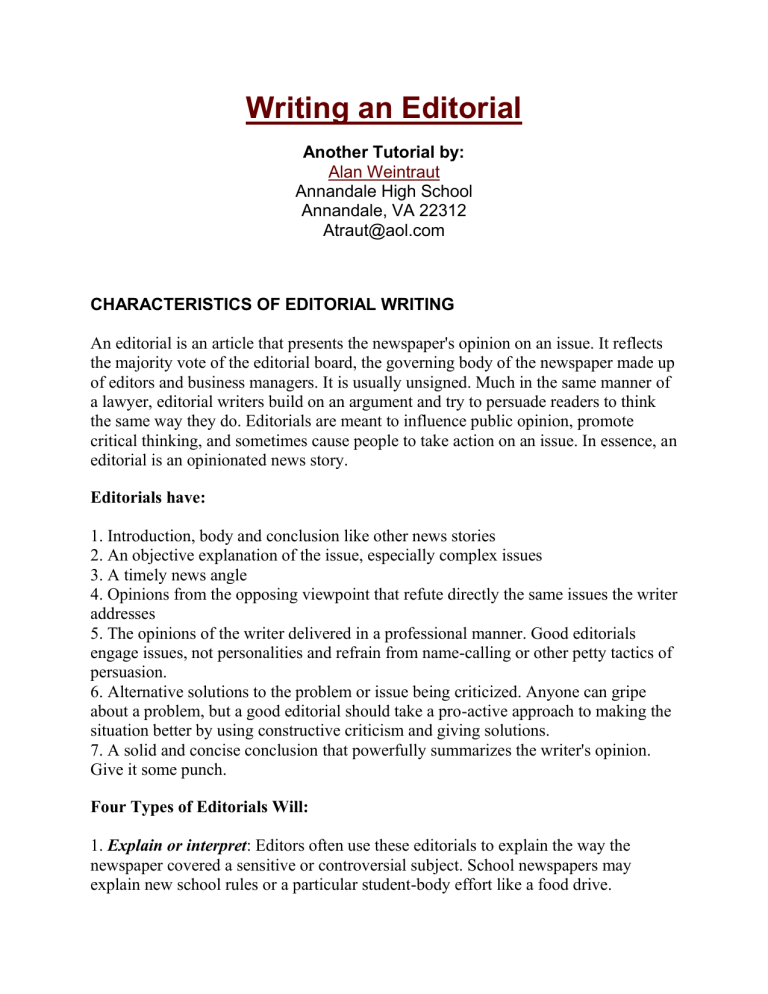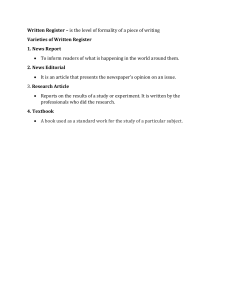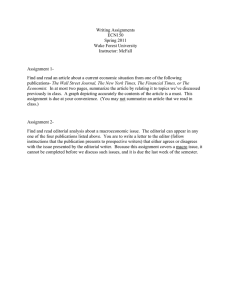
Writing an Editorial Another Tutorial by: Alan Weintraut Annandale High School Annandale, VA 22312 Atraut@aol.com CHARACTERISTICS OF EDITORIAL WRITING An editorial is an article that presents the newspaper's opinion on an issue. It reflects the majority vote of the editorial board, the governing body of the newspaper made up of editors and business managers. It is usually unsigned. Much in the same manner of a lawyer, editorial writers build on an argument and try to persuade readers to think the same way they do. Editorials are meant to influence public opinion, promote critical thinking, and sometimes cause people to take action on an issue. In essence, an editorial is an opinionated news story. Editorials have: 1. Introduction, body and conclusion like other news stories 2. An objective explanation of the issue, especially complex issues 3. A timely news angle 4. Opinions from the opposing viewpoint that refute directly the same issues the writer addresses 5. The opinions of the writer delivered in a professional manner. Good editorials engage issues, not personalities and refrain from name-calling or other petty tactics of persuasion. 6. Alternative solutions to the problem or issue being criticized. Anyone can gripe about a problem, but a good editorial should take a pro-active approach to making the situation better by using constructive criticism and giving solutions. 7. A solid and concise conclusion that powerfully summarizes the writer's opinion. Give it some punch. Four Types of Editorials Will: 1. Explain or interpret: Editors often use these editorials to explain the way the newspaper covered a sensitive or controversial subject. School newspapers may explain new school rules or a particular student-body effort like a food drive. 2. Criticize: These editorials constructively criticize actions, decisions or situations while providing solutions to the problem identified. Immediate purpose is to get readers to see the problem, not the solution. 3. Persuade: Editorials of persuasion aim to immediately see the solution, not the problem. From the first paragraph, readers will be encouraged to take a specific, positive action. Political endorsements are good examples of editorials of persuasion. 4. Praise: These editorials commend people and organizations for something done well. They are not as common as the other three. Writing an Editorial 1. Pick a significant topic that has a current news angle and would interest readers. 2. Collect information and facts; include objective reporting; do research 3. State your opinion briefly in the fashion of a thesis statement 4. Explain the issue objectively as a reporter would and tell why this situation is important 5. Give opposing viewpoint first with its quotations and facts 6. Refute (reject) the other side and develop your case using facts, details, figures, quotations. Pick apart the other side's logic. 7. Concede a point of the opposition — they must have some good points you can acknowledge that would make you look rational. 8. Repeat key phrases to reinforce an idea into the reader's minds. 9. Give a realistic solution(s) to the problem that goes beyond common knowledge. Encourage critical thinking and pro-active reaction. 10. Wrap it up in a concluding punch that restates your opening remark (thesis statement). 11. Keep it to 500 words; make every work count; never use "I" A Sample Structure I. Lead with an Objective Explanation of the Issue/Controversy. Include the five W's and the H. (Members of Congress, in effort to reduce the budget, are looking to cut funding from public television. Hearings were held …) Pull in facts and quotations from the sources which are relevant. Additional research may be necessary. II. Present Your Opposition First. As the writer you disagree with these viewpoints. Identify the people (specifically who oppose you. (Republicans feel that these cuts are necessary; other cable stations can pick them; only the rich watch public television.) Use facts and quotations to state objectively their opinions. Give a strong position of the opposition. You gain nothing in refuting a weak position. III. Directly Refute The Opposition's Beliefs. You can begin your article with transition. (Republicans believe public televison is a "sandbox for the rich." However, statistics show most people who watch public television make less than $40,000 per year.) Pull in other facts and quotations from people who support your position. Concede a valid point of the opposition which will make you appear rational, one who has considered all the options (fiscal times are tough, and we can cut some of the funding for the arts; however, …). IV. Give Other, Original Reasons/Analogies In defense of your position, give reasons from strong to strongest order. (Taking money away from public television is robbing children of their education …) Use a literary or cultural allusion that lends to your credibility and perceived intelligence (We should render unto Caesar that which belongs to him …) V. Conclude With Some Punch. Give solutions to the problem or challenge the reader to be informed. (Congress should look to where real wastes exist — perhaps in defense and entitlements — to find ways to save money. Digging into public television's pocket hurts us all.) A quotation can be effective, especially if from a respected source A rhetorical question can be an effective concluder as well (If the government doesn't defend the interests of children, who will?) Go to the library or any computer lab and complete the “webquest” located at An editorial is a newspaper article that expresses the opinion of the author. It can be about any topic but is usually written about an issue that deals with our society. To build credibility, the opinion in the editorial must be backed up with facts and evidence to substantiate it. Learning how to write an editorial is a great exercise in sharing opinions. Steps for Writing an Editorial The steps you need to write a successful editorial piece are similar to the steps for writing an argumentative essay. 1. Choose a Topic That’s Important to You The topic you choose is the most important part of writing a newspaper editorial. The best topics are current issues in our society that you’re passionate about. If the topic is a current issue that everyone is already interested in, then your editorial piece will engage the reader's attention. If the topic you choose is an ongoing issue in society, make sure to use the most recent information. However, you can use older information as sources to help prove your case. ADVERTISEMENT 2. Identify the Type of Editorial You Want to Write There are four different types of editorials. Each has a specific purpose, and knowing your purpose can help you set up your editorial. Explanatory or Interpretive - explains certain rules or why something was done a specific way Critical - showcases a problem by criticizing related actions or decisions Persuasive - showcases and endorses a specific solution so readers will be compelled to endorse it as well Praising - commends someone or a group for the way they handled a situation or problem 3. Form Your Opinion Start by deciding your stance on the topic you’ve chosen. You cannot be on both sides of the fence when writing an editorial piece — the purpose of the editorial is to give your opinion. With this in mind, you must feel strongly about your viewpoint and be able to give a strong, persuasive argument in favor of it. If you don’t feel strongly about the topic at hand, readers won’t be particularly inclined to see your point of view. ADVERTISEMENT 4. Find Factual Support Although you’re providing your opinion, you still want to back up your argument with facts. Use facts that corroborate the point of view you want to argue. You can include facts pertaining to both sides of the argument, if they help you make your point. 5. Outline Your Editorial As with any type of research paper, it’s a good idea to write an outline. With an outline, you know where you stand on the issue. The outline helps you get your thoughts and opinions in order and keeps you focused on your stance and purpose. A standard editorial outline might include: Introduction - the hook and lead Body - the opposition’s stance Body - why the opposition is incorrect Body - your reasons to defend your stance Conclusion - summary and solutions ADVERTISEMENT 6. Write Your Article The first step to writing your newspaper editorial is to write a lead (also known as a “lede”) that grabs readers' attention. If you grab their attention from the very beginning, they are more inclined to keep reading. Your opinion on the topic should be addressed right away — if not in the lead, then in the first paragraph. Newspaper editorials should have at least three arguments supporting your position. These arguments should be backed up with facts and evidence from your research on the topic. Use statistics to help prove your argument. Make sure your strongest argument is left for last. Do not be passive in the arguments that come before the strongest. If this happens, readers aren’t likely to read your entire editorial. In a newspaper editorial, your conclusion (also known as the “kicker”) should sum up all the information you wrote about. It ties your arguments together and gives readers a recap of all the facts that you presented. Then you should add a few solutions you think would help solve the issue. An editorial is not about simply throwing down your thoughts on a subject and expecting people to agree with you. Your article should explain the issue, criticize current decisions or actions, persuade readers to agree with your way of thinking, and offer solutions. A newspaper editorial should be reasoned, not ranting.



